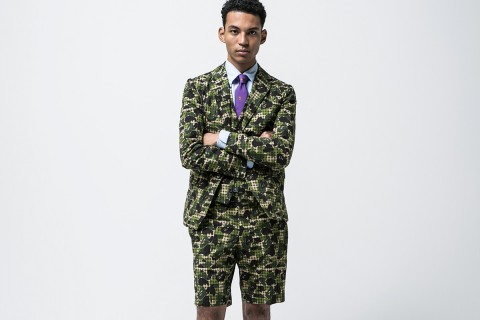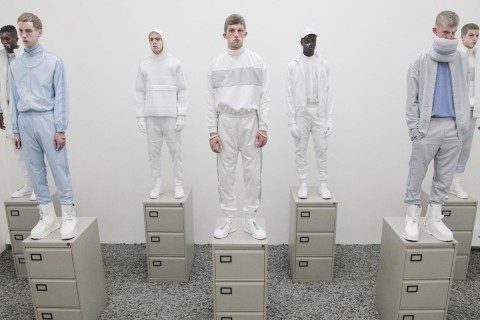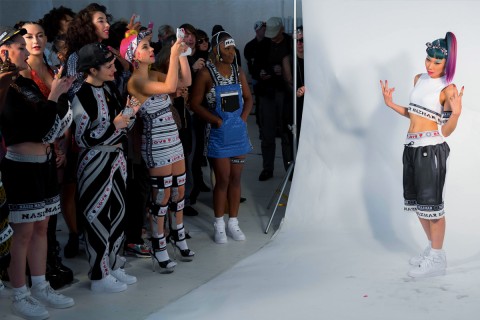Ever since Vision first patented the term “streetwear” nearly 30 years ago, the word has morphed beyond recognition. From those early years it has transformed into a sort of catch-all umbrella categorisation that extends across parts of surf culture, skateboarding, sportswear, and a whole plethora of informal, luxury and non-luxury menswear — although it never truly encapsulates any of them.
With every passing season streetwear’s definition becomes increasingly broad and imperfect. Yet, despite being so difficult to pin down succinctly, it’s also a badge that has, in fashion terms at least, become a bit of a dirty word.
In recent years the boundaries of the term “streetwear” have encroached onto high fashion territory through the likes of Hood By Air, Cottweiler, Gosha Rubchinskiy, Astrid Andersen and Nasir Mazhar, to name but a few. Meanwhile, the bipartisan appeal of brands such as Palace, Supreme and Thrasher, in addition to the fashion world’s own long-running fetishisation of the street, has blurred the divide that traditionally separated the runway from the sidewalk.
While this broadening of the church has been largely embraced by consumers on both sides of the divide, when it comes to the industry, some of those caught in the middle of that overlap have been less than enthusiastic. On the fashion side in particular, certain figures have done their best to make streetwear feel like an unwelcome guest at the party.
In his London Collections: Men SS15 round up for the Financial Times, menswear reporter Charlie Porter wrote “the words sportswear or streetwear are demeaning to the city’s young designers: what they’re creating is pure fashion.”
Nasir Mazhar further reinforced the distinction between streetwear and haute couture in an interview he gave to Dazed, stating “It’s fashion, but the minute people see black or non-white models and casual silhouettes, they think it’s streetwear … Givenchy sells trackies, and sweaters and T-shirts, but Givenchy would die if they called it streetwear!” Others, like Kanye collaborator, Heron Preston, got downright derogatory, telling Amuse “I just recently declined sitting on a streetwear panel because I just hate the word … It’s too narrow-minded and cheesy.”

So what is it about “streetwear” that makes fashion designers retch and recoil like a child struggling to squirm out of a schoolyard kiss? Well, in Mazhar’s words, as reported by the Guardian, it’s because “[he’s] always associated the term with brands that mainly do T-shirts and sweatshirts. They’re not full-on fashion brands. So, in that sense, it’s belittling.”
And he kind of has a point. Looking at Complex’s list of the 50 greatest streetwear brands, most of them are known for little more than printing graphic tees. Even the author of the admittedly dated list (it was written in 2011), Bobby Hundreds — himself the co-founder of an archetypal old skool streetwear brand — confesses “every line on this list, with a few exceptions, has built their brand off T-shirts”.
Despite the aspirational moves that brands like OFF-WHITE and Fear of God have made towards sophisticating the field in recent seasons, streetwear is, in fashion terms, still a byword for low brow — which is kind of understandable: after all, a Crooks & Castles collection is never going to earn its creators an honorary degree from Central Saint Martins. While high fashion relies on craft, artistry, and a sizeable dose of theoretical experimentation, many streetwear brands have, in the past, been overly dependant on hype and gimmickry, giving the field a certain reputation that’s proving difficult to shake off.

Take BAPE as an example: despite being one of the preeminent brands in its field (at least, once upon a time), capsule collections that pay tribute to the likes of Hello Kitty and SpongeBob SquarePants do little for the artistic credibility of the sphere in which it operates. To outsiders it looks juvenile, and for a subsegment of fashion typically associated with adolescence and ageing men who refuse to let go of it, it only further ingrains this sort of stigmatization.
Supreme is sometimes held aloft as an exception in this regard, given its historical ties to fashion figures like Kate Moss and Terry Richardson. Yet, while its cult status has undoubtedly made it a “slum favourite” of off-duty models and street style peacocks, the level of technical innovation that goes into its products isn’t exactly catwalk grade. Meanwhile, its use of cheaper materials like acrylic in its knitwear and the increasingly high percentage of its goods made in places like China certainly wouldn’t meet the standards of a bone-fide fashion label.
While celebrity-driven campaigns hinged on the likes of Neil Young, H.R. Giger and Kermit the Frog aim for a certain Warholian cultural irreverence, Supreme’s scattergun randomness and lack of any coherent strategy beyond mere celeb-affiliated appeal lacks real depth. For some (myself included) the brand feels closer to Planet Hollywood than insightful pop art.

This might sound harsh, but just take a second to contrast Supreme’s approach with that of a brand like Cottweiler. When creating the “robe trackpants,” the brand’s designers took the tracksuit bottom, a garment typically associated with loutish working class youth, and fused it with cultish ceremonial robes, juxtaposing hardened street utilitarianism with the delicate intimacy of faith-based worship. Nasir Mazhar, meanwhile, peers at contemporary British-Caribbean culture through the unfamiliar lens of high fashion, reimagining it in a world to which it is utterly antithetical and subversive.
This kind of “art school” thinking is far subtler and more evolved than, say, simply sticking E.T.’s face on a hoodie. If the two styles were movie directors, it would be like equating the works of Michael Haneke with those of Kevin Smith or Larry Clarke. With that in mind, it’s perhaps easy to understand why a true fashion designer with years of training behind them would resist being lumped in the “streetwear” box. Yet, while the criticisms of over-simplicity levelled at this scene by fashion designers aren’t entirely unfounded, they are at times outdated.
The fact of the matter is that streetwear has evolved considerably over the past five years or so, and has matured away from the likes of those names on Mr Hundreds’ aforementioned list. Aside from the top three names he mentioned — Stussy, BAPE, and Supreme — the vast majority of the remaining brands have far less relevance to the current state of streetwear today than they did a decade or more ago.
These days, looking at the creations of a brand like Virgil Abloh’s OFF-WHITE, they’re more reliant on the thread and needle than they are the silkscreen. Brands like Pigalle can happily produce run of the mill graphic tees and sweats for the basketball court, yet still craft highly conceptual collections for the catwalk, while Nike and adidas continue to flirt with card-carrying members of the fashion elite like Yohji Yamamoto, Riccardo Tisci, Raf Simons, Rick Owens and many more. Even more traditional streetwear forces like KITH make use of premium fabrics and more adventurous cuts, nestling alongside higher-priced, premium brands like Fear of God, 424 and Midnight Studios.

This, in turn, raises the question: what exactly separates high-minded “streetwear” from runway fashion? What makes them mutually exclusive? Who can authoritatively say what each one is and back that up with a definitive explanation (especially in an age where the boundaries are so increasingly indistinct)? In many ways the term “streetwear” seems to be about as difficult to define as that other lazy and heavily loaded post-millennial tag thrown around without any serious thought: “hipster.”
To my mind it’s clear that streetwear isn’t what it once was, and that a third way has opened up — one that bridges the everyday street style/fantasy haute couture divide. It’s a segmented market with a lower and upper echelon, and while one is better suited to the Vans Warped Tour and the other is made for the Marais, it’s reductive to say one is conclusively superior to the other. That’s a debate as subjective and futile as trying to decide *the best* musical genre.
In many ways the kind of grievances aired by Nasir Mazhar and his ilk come down to concerns over pigeonholing. “Streetwear” is a word loaded with certain racial, cultural and intellectual connotations, bound to the image of baggy-clothed young black men, loitering on street corners, like some outdated Boyz n the Hood cliché (when the reality is probably far closer to overly-enthusiastic, well-financed, trend-aware Asian kids camping out for the latest YEEZY drop). In that case it seems to me that, whether he realises it or not, Mazhar’s beef isn’t with streetwear itself, but the semantic baggage that comes with it — semantic baggage heaped on by the very same fashion world he is so keen to be a part of.
Maybe streetwear needs a rebranding (“street couture,” anyone?), or maybe it’ll just take some time for the fashion world to catch up. Time will tell, but let’s all just agree on one thing: no more Spongebob capsule collections, please.
The views and opinions expressed in this piece are those of the author, and do not necessarily reflect the position of Highsnobiety as a whole.

